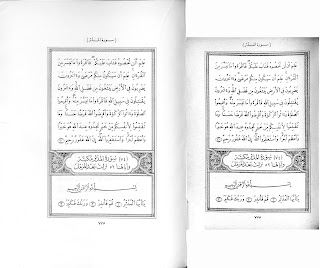Gotthelf Bergsträßer was a philologist, a linguist,
but during his three months in Cairo 1929/30 he listened (and recorded)
recitation lessons by the best of Egypt's qurrāʾ ‒ he observed
listened, interviewed in the way of (musical) anthropologists.
And he interviewed the chief editor of the 1924 King Fuʾād Edition
and the chief editor of the (future) 1952 Edition.
The 19th century brought changes to the world of Islam by material change:
lithography, telegraph and steam ship changed the availability of maṣāḥif and news and the ease of making the haǧǧ. Now, there was a steady community of Šafiʿi scholars from the Malay world/archipelago in Mecca, and books in the Malay language (in Jawi script) were printed in Istambul, Mecca and Cairo.
For about twenty years I was looking for the muṣḥaf mentioned by G. Bergsträßer, that was printed in Cairo by Muṣṭafā al-Bābī al-Ḥalabī for al-Maktaba an-Nabhāniyya al-Kubrā of Sālim & Aḥmad ibn Saʿd an-Nabhān.
It looks like that the National & University Library of the Hanse City of Hamburg owns a copy ‒ helas without cover, title page or colophone. But they have a good copy of an enlarged edition made three years later (with a guarantee by the (Egyptian) Ministery of the Interior for its correctness).
For the first muṣḥaf printed in what is now Indonesia,
the one printed in Singapure for and written by Muḥammad al-Azharī,
resident of Palembang, South-East Sumatra, see Ali Akbars blog. Here is the colophon from the first edition
and the translation by Ian Proudfoot (Lithography at the Crossroads of the East p. 129)
To begin with, this holy Quran was printed by lithographic press, that is to say on a stone press in the handwriting of the man of God Almighty, Haji Muhammad Azhari son of Kemas Haji Abdullah, resident of Pelambang, follower of the Shafi'i school, of the Ash'arite conviction [etc . ... ]. The person who executed this print is Ibrahim bin Husain, formerly of Sahab Nagur and now resident in Singapore, a pupil of Abdullah bin Abdul Kadir Munshi of Malacca. The printing was finished on Monday the twenty-first day of the month of Ramadan according to the sighting of the new moon at Palembang, in the year of the Prophet's Hijra - may God's blessings and peace be upon him - twelve hundred and sixty-four, 1264. This coincides with the twenty-first day of the month of August in the Christian year eighteen hundred and forty-eight, 1848, and the sixteenth day of the month of Misra in the Coptic year fifteen hundred and sixty-four, 1564 [etc ... ]. The number of Qur'ans printed was one hundred and five. The time taken to produce them was fifty days, or two Qurans and three sections per day. The place where the printing was done was the city of Pal em bang, in the neighbourhood of the Third Upstream Village, on the left bank, going upstream from the settlement of Demang Jayalaksana Muhammad N ajib, son of the deceased Demang Wiralaksana Abdul Khalik. May God the All-Holy and Allmighty bestow forgiveness on those have copied this, who have printed this, and who will read this, and upon their forebears and upon all Muslim men and women and their forebears.The cover of the second edition 1854 (from Proudfoot):
and the colophon (from Ali Akbar):



















































